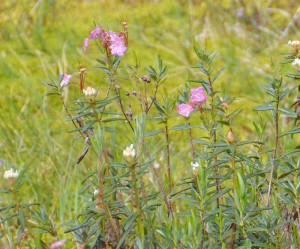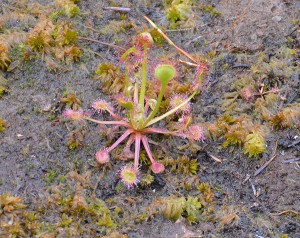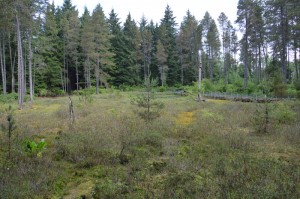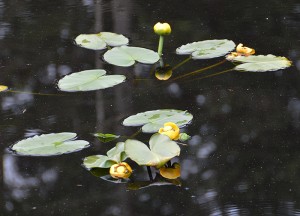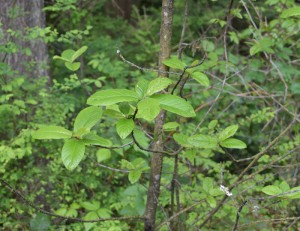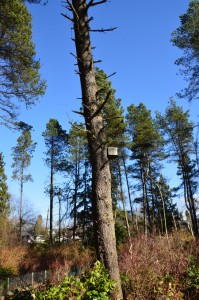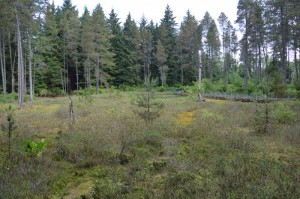 Even though the Camosun Bog is not very large, there is lots to look at! Bog plants you can find include: numerous species of Sphagnum, cranberry (Vaccinium oxycoccus), Labrador tea (Rhododendron groenlandicum), sundew (Drosera rotundifolia), bog laurel (Kalmia microphylla), blueberry (Vaccinium myrtilloides, V. ovalifolium, V. uliginosum), shore pine (Pinus contorta), and cloudberry (Rubus chamaemorus). CAMOSUN BOG PLANT CHECKLIST
Even though the Camosun Bog is not very large, there is lots to look at! Bog plants you can find include: numerous species of Sphagnum, cranberry (Vaccinium oxycoccus), Labrador tea (Rhododendron groenlandicum), sundew (Drosera rotundifolia), bog laurel (Kalmia microphylla), blueberry (Vaccinium myrtilloides, V. ovalifolium, V. uliginosum), shore pine (Pinus contorta), and cloudberry (Rubus chamaemorus). CAMOSUN BOG PLANT CHECKLIST
 The most important genus in the bog is Sphagnum. There have been 14 species identified in Camosun Bog. Bog topography is lumpy with its hummocks (mounds). Sphagnum species are very particular about where they live. Some live atop the hummocks while others live in the depressions between them and still others are aquatic. In the picture on the left the red Sphagnum is S. capillifolium. It can also be green. Other Sphagnums also change pigmentation so over the course of the year you may notice the bog changes colour.
The most important genus in the bog is Sphagnum. There have been 14 species identified in Camosun Bog. Bog topography is lumpy with its hummocks (mounds). Sphagnum species are very particular about where they live. Some live atop the hummocks while others live in the depressions between them and still others are aquatic. In the picture on the left the red Sphagnum is S. capillifolium. It can also be green. Other Sphagnums also change pigmentation so over the course of the year you may notice the bog changes colour.
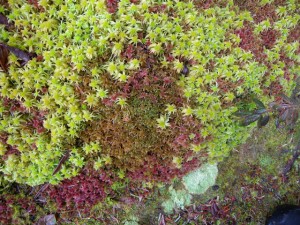 This close-up shows you some of the beautiful colours of Sphagnum. Sphagnum fuscum is the olive green moss. It can also be dark chocolaty brown. For more information on Sphagnum check out this website.
This close-up shows you some of the beautiful colours of Sphagnum. Sphagnum fuscum is the olive green moss. It can also be dark chocolaty brown. For more information on Sphagnum check out this website.
OTHER BOG PLANTS:
Rhododendron groenlandicum (Labrador tea)
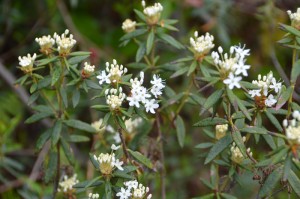
Drosera rotundifolia (sundew) – insectivorous plant
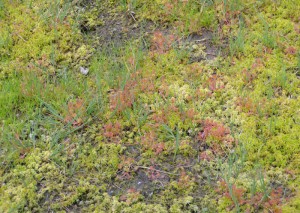
Rubus chamaemorus (Cloudberry)
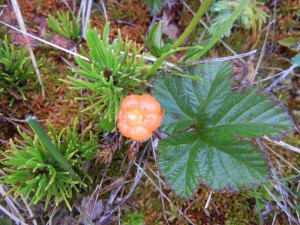 I kind of cheated on this picture. It was taken in Haida Gwaii (bog off White Creek Trail).
I kind of cheated on this picture. It was taken in Haida Gwaii (bog off White Creek Trail).
Polytrichastrum formosum (Bank haircap moss)
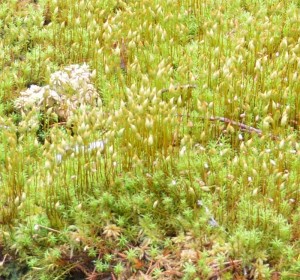 This hair cap moss is common in Camosun Bog. There is concern that it is overtaking the Sphagnum.
This hair cap moss is common in Camosun Bog. There is concern that it is overtaking the Sphagnum.
Rhamnus purshiana (cascara)
 The bark of this plant is used as a laxative!
The bark of this plant is used as a laxative!

